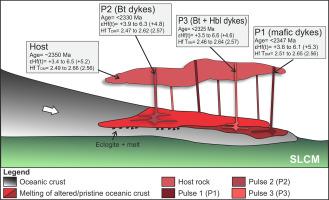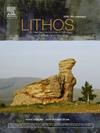圣弗朗西斯科克拉通南部米内罗带海洋地壳内部熔融揭示的西德岩浆脉冲的多样性
IF 2.9
2区 地球科学
Q2 GEOCHEMISTRY & GEOPHYSICS
引用次数: 0
摘要
早古生代在很大程度上被认为是全球岩浆减缓的时期(∼2.3-2.2 Ga)。位于巴西圣弗朗西斯科克拉通南部米涅罗带的Lagoa Dourada成套岩体是一个2350 Ma TTG成套岩体,是一个年轻的高铝成套岩体,在空间上与一个堤坝网络相关,但在文献中却很少受到关注。根据野外特征、岩相学、全岩地球化学、锆石中的 U-Th-Pb 和 Hf 同位素,我们认为这些堤坝代表了通过大洋地壳的地壳内熔融产生的三个不同的岩浆脉冲。脉动1(2347 Ma)为同步岩浆型,具有低SiO2、高Mg#和HREE、中等[La/Yb]N和低Ba+Sr含量。脉冲 2(约 2330 Ma)具有高 SiO2、低 Mg# 和 HREE、中等 [La/Yb]N 和高 Ba+Sr 值。脉冲 3(约 2325 Ma)具有中等 SiO2、低 Mg#、高 HREE、中等至高 [La/Yb]N 和高 Ba+Sr 值。它们的 Hf 成分与主岩大致相似,εHf(t) 值为正,Hf-TDM 模型年龄为 2.65 至 2.46 Ga,证明了它们的幼年性质。这些特征,加上它们同质的 Hf 特征(176Hf/177Hf = 0.281382 至 0.281481),表明所有这些岩浆脉冲都来自一个相似的来源。然而,岩堤和主岩的全岩化学多样性表明,该岩源岩内部存在化学异质性,以及/或不同的岩浆脉冲是在大约25Ma的时间里,通过不同程度的部分熔融托勒密玄武岩岩源而产生的。这些发现揭示了岩浆成分的广泛多样性,这些岩浆形成了横切多拉戈达岩浆岩组的岩堤网络,从而形成了圣弗朗西斯科克拉通南缘的幼年大陆地壳框架。此外,这些岩石构成了幼年岩浆活动的一个奇特实例,有助于更好地了解这一时期的构造-岩浆沉积和潜在的岩石学过程。本文章由计算机程序翻译,如有差异,请以英文原文为准。

Diversity of Siderian magmatic pulses revealed by intracrustal melting of oceanic crust in the Mineiro Belt, southern São Francisco Craton
The early Paleoproterozoic Era has been largely recognized as a period of global magmatic slowdown (∼2.3–2.2 Ga). The Lagoa Dourada Suite, located in the Mineiro Belt – southern São Francisco Craton - Brazil, is a juvenile high‑aluminum 2350 Ma TTG suite and spatially associated with a network of dykes that received little attention in the literature. Based on field features, petrography, whole-rock geochemistry, U-Th-Pb, and Hf isotopes in zircons, we propose that these dykes represent three different magmatic pulses produced via intracrustal melting of oceanic crust. Pulse 1 (<2347 Ma) is syn-plutonic with low-SiO2, high-Mg# and HREE, moderate [La/Yb]N, and low Ba+Sr contents. Pulse 2 (ca. <2330 Ma) shows high-SiO2, low-Mg# and HREE, moderate [La/Yb]N, and high Ba+Sr. Pulse 3 (ca. <2325 Ma) has intermediate-SiO2, low-Mg#, high HREE, moderate to high [La/Yb]N, and high Ba+Sr values. Their Hf compositions are broadly similar to those of the host rock, with positive εHf(t) values and the Hf-TDM model ages ranging from 2.65 to 2.46 Ga, attesting to their juvenile nature. These characteristics, coupled with their homogeneous Hf signature (176Hf/177Hf = 0.281382 to 0.281481), suggest that all these magmatic pulses came from a similar source. However, the whole-rock chemical diversity of the dykes and host rock suggests chemical heterogeneities within this source rock and/or the different magmatic pulses were generated by variable degrees of partial melting of a tholeiitic metabasaltic source throughout approximately 25 Ma. These findings reveal a wide compositional diversity of magmas that gave rise to a network of dykes crosscutting the Lagoa Dourada Suite and, consequently, to the framework of a juvenile continental crust on the southern margin of the São Francisco Craton. Furthermore, these rocks constitute a singular example of juvenile magmatism and contribute to a better understanding of the tectono-magmatic lull and potential petrological processes during this period.
求助全文
通过发布文献求助,成功后即可免费获取论文全文。
去求助
来源期刊

Lithos
地学-地球化学与地球物理
CiteScore
6.80
自引率
11.40%
发文量
286
审稿时长
3.5 months
期刊介绍:
Lithos publishes original research papers on the petrology, geochemistry and petrogenesis of igneous and metamorphic rocks. Papers on mineralogy/mineral physics related to petrology and petrogenetic problems are also welcomed.
 求助内容:
求助内容: 应助结果提醒方式:
应助结果提醒方式:


